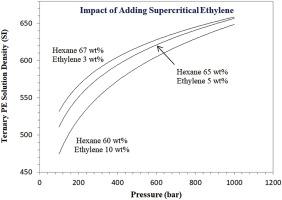Journal of Molecular Graphics and Modelling ( IF 2.9 ) Pub Date : 2020-08-04 , DOI: 10.1016/j.jmgm.2020.107709 Moeed Shahamat 1 , Alejandro D Rey 1

|
The understanding of polymer solution thermodynamics and characterization of pressure effects on fundamental polymer physics of macromolecular systems is significant in the manufacturing of polyolefins. Consequently, numerous experimental and theoretical efforts have been made towards understanding phase behavior of polymer solutions at elevated pressures. Despite this progress, only limited efforts are directed towards understanding the underlying phenomena behind the influence of high pressure upon the thermophysical properties of ternary polymer solutions at a molecular level. The present paper, therefore, reports on the influence of supercritical ethylene on the density of PE + hydrocarbon solvent system by exploring ternary mixtures of PE + hexane + ethylene for ethylene concentrations up to 10 wt% at varied temperatures and in a pressure range from 100 to 1000 bar via fully-atomistic molecular dynamics (MD) simulations. Additionally, the modified Sanchez-Lacombe equation of state (EOS) model is iteratively solved to capture the pressure, concentration, and temperature dependence of ternary PE solution density. It is shown that the small amounts of ethylene dissolved in the liquid mixtures of PE + hexane significantly decreases the polymer solution density. The presence of unreacted monomer in the solution polymerization process utilized in PE manufacturing was found to substantially lower the PE solution density particularly at the lower end of the investigated pressure range. This noteworthy reduction in mixture density as a consequence impacts design and operation of the liquid-liquid phase separator in manufacturing of PE via solution polymerization. Another key point to bear in mind is that the mixture density exhibits fairly less sensitivity to ethylene amount as external pressure raises. Nevertheless, pressure, solvent composition, and temperature dependence of density display less sensitivity as pressure increases. In relation to the characterization of the impact of addition of ethylene an atomistic-level insight is provided, which proves to be of great value in revealing intermolecular interactions in the binary subsystems of polymer/solvent/monomer. The MD computations are shown to be in excellent agreement with the theoretical EOS model, confirming the validity of the proposed methodology. Furthermore, the adopted OPLS-AA has been found a reliable atomistic force field, which provides detailed molecular information on the thermophysical properties of polyolefin in hydrocarbon solutions. Ultimately, it is demonstrated that the MD simulations complement parametric EOS predictions and costly experimental approaches.
中文翻译:

超临界聚乙烯+己烷+乙烯系统的状态方程和基于力场的分子动力学模拟。
对聚合物溶液热力学的理解以及对大分子系统基本聚合物物理的压力影响特性的了解在聚烯烃的制造中具有重要意义。因此,已经进行了许多实验和理论上的努力来理解在高压下聚合物溶液的相行为。尽管取得了这一进展,但是只有有限的努力致力于理解在分子水平上高压对三元聚合物溶液的热物理性质的影响背后的潜在现象。因此,本文件 通过探索PE +己烷+乙烯的三元混合物在不同温度和100至1000 bar的压力范围内,最高浓度为10 wt%的乙烯浓度下,研究了超临界乙烯对PE +烃溶剂体系密度的影响。原子分子动力学(MD)模拟。此外,迭代求解改进的Sanchez-Lacombe状态方程(EOS)模型,以捕获三元PE溶液密度的压力,浓度和温度依赖性。结果表明,少量溶于PE +己烷混合液中的乙烯会显着降低聚合物溶液的密度。发现在PE制造中使用的溶液聚合过程中未反应单体的存在显着降低了PE溶液密度,特别是在所研究的压力范围的较低端。结果,混合物密度的这种显着降低影响了通过溶液聚合制造PE时液-液相分离器的设计和操作。要记住的另一个关键点是,随着外部压力的升高,混合物密度对乙烯含量的敏感性降低。然而,随着压力的增加,压力,溶剂组成和密度的温度依赖性显示出较小的灵敏度。关于乙烯添加影响的表征,提供了原子级的见解,在揭示聚合物/溶剂/单体的二元子系统中的分子间相互作用方面,它具有重要的价值。MD计算结果与EOS理论模型非常吻合,证实了所提出方法的有效性。此外,已发现采用的OPLS-AA是可靠的原子力场,该场提供了有关烃溶液中聚烯烃的热物理性质的详细分子信息。最终,证明了MD仿真可以补充参数EOS预测和昂贵的实验方法。已发现采用的OPLS-AA是可靠的原子力场,它提供了有关烃溶液中聚烯烃的热物理性质的详细分子信息。最终,证明了MD仿真可以补充参数EOS预测和昂贵的实验方法。已发现采用的OPLS-AA是可靠的原子力场,它提供了有关烃溶液中聚烯烃的热物理性质的详细分子信息。最终,证明了MD仿真可以补充参数EOS预测和昂贵的实验方法。


























 京公网安备 11010802027423号
京公网安备 11010802027423号